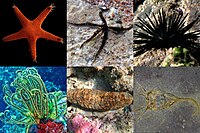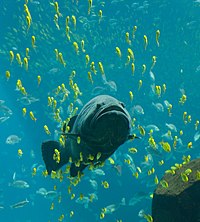
Fatty Acids of Abyssal Echinodermata, the Sea Star Eremicaster vicinus and the Sea Urchin Kamptosoma abyssale: A New Polyunsaturated Fatty Acid Detected, 22:6(n-2).
Sign Up to like & getrecommendations! Published in 2020 at "Lipids"
DOI: 10.1002/lipd.12227
Abstract: Fatty acids (FA) of two species of abyssal Echinodermata-the sea star (Asteroidea) Eremicaster vicinus and the sea urchin (Echinoidea) Kamptosoma abyssale-from the Kuril-Kamchatka Trench, collected at depths of 5210 and 6183 m, were analyzed. Lipids of… read more here.
Keywords: echinodermata sea; sea; abyssal echinodermata; eremicaster vicinus ... See more keywords

The stars are out: Predicting the effect of seawater freshening on the ecological impact of a sea star keystone predator
Sign Up to like & getrecommendations! Published in 2021 at "Ecological Indicators"
DOI: 10.1016/j.ecolind.2021.108293
Abstract: Highlights: • Effect of sea freshening on keystone predator impact, Asterias rubens, assessed. • Three ecologically relevant salinity treatments (18, 15, 12ppt). • Zero consumption occurred at the lowest, “future” treatment. • Consumption found to… read more here.
Keywords: keystone predator; sea; impact; sea star ... See more keywords

Not all prey are created equal: Invasive ascidian diet mediates sea star wasting in Henricia sanguinolenta
Sign Up to like & getrecommendations! Published in 2021 at "Journal of Experimental Marine Biology and Ecology"
DOI: 10.1016/j.jembe.2021.151610
Abstract: Abstract Disease outbreaks and mass mortality events in terrestrial and marine taxa are increasing as a result of human influence, pollution, and climate change. Sea Star Wasting has become more common on the west coast… read more here.
Keywords: star wasting; sea star; prey created; mortality ... See more keywords

Sunflower sea star predation on urchins can facilitate kelp forest recovery
Sign Up to like & getrecommendations! Published in 2023 at "Proceedings of the Royal Society B: Biological Sciences"
DOI: 10.1098/rspb.2022.1897
Abstract: The recent collapse of predatory sunflower sea stars (Pycnopodia helianthoides) owing to sea star wasting disease (SSWD) is hypothesized to have contributed to proliferation of sea urchin barrens and losses of kelp forests on the… read more here.
Keywords: sunflower sea; pycnopodia; kelp forest; sea ... See more keywords

Locomotion via Active Suction in a Sea Star-Inspired Soft Robot
Sign Up to like & getrecommendations! Published in 2022 at "IEEE Robotics and Automation Letters"
DOI: 10.1109/lra.2022.3191181
Abstract: Some marine animals, such as sea stars, have developed versatile adhesive appendages that can be used for a variety of behaviors including sticking to surfaces, manipulating objects, and locomoting. These appendages couple reversible adhesion capabilities… read more here.
Keywords: locomotion via; suction; active suction; sea star ... See more keywords

The skeletal proteome of the sea star Patiria miniata and evolution of biomineralization in echinoderms
Sign Up to like & getrecommendations! Published in 2017 at "BMC Evolutionary Biology"
DOI: 10.1186/s12862-017-0978-z
Abstract: BackgroundProteomic studies of skeletal proteins have revealed large, complex mixtures of proteins occluded within the mineral. Many skeletal proteomes contain rapidly evolving proteins with repetitive domains, further complicating our understanding. In echinoderms, proteomic analysis of… read more here.
Keywords: star patiria; proteome sea; skeletal proteome; sea star ... See more keywords

Antibacterial potential of Luidia clathrata (sea star) tissue extracts against selected pathogenic bacteria
Sign Up to like & getrecommendations! Published in 2023 at "PLOS ONE"
DOI: 10.1371/journal.pone.0281889
Abstract: As resistance to traditional antibiotics has become a major issue, it is essential to explore natural sources for new antimicrobial agents. The marine environment offers a variety of natural bioactive compounds. In this study, we… read more here.
Keywords: potential luidia; luidia clathrata; sea star; antibacterial potential ... See more keywords

Chemical defense in developmental stages and adult of the sea star Echinaster (Othilia) brasiliensis
Sign Up to like & getrecommendations! Published in 2021 at "PeerJ"
DOI: 10.7717/peerj.11503
Abstract: To date, evidence regarding the performance of secondary metabolites from larval stages of sea stars as an anti-predation defense relates only to a few species/specimens from a few geographic ranges. Unfortunately, this hinders a comprehensive… read more here.
Keywords: sympatric allopatric; developmental stages; chemical defense; sea star ... See more keywords